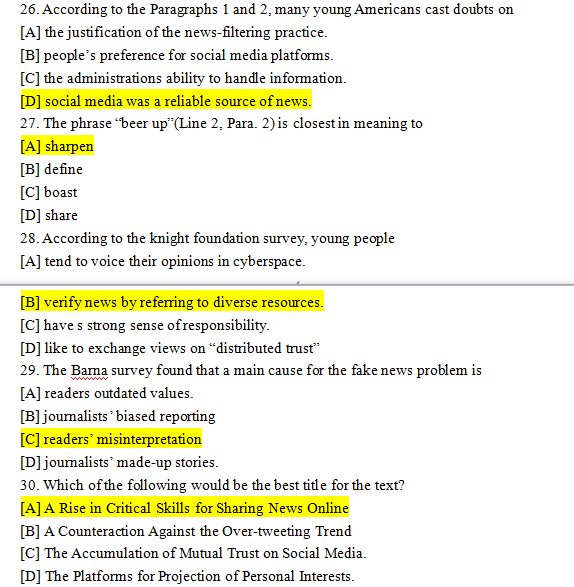2018�꿼�С�Ӣ�Zһ�����}����(�Ķ�������)
| �� 1 퓣�Section I Use of English |
| �� 2 퓣�Section II Reading Comprehension |
| �� 6 퓣�Part B |
| �� 7 퓣�Part C |
| �� 8 퓣�Section III Writing |
����Text 2
����A new survey by Harvard University finds more than two-thirds of young Americans disapprove of President Trump��s use of Twitter. The implication is that Millennials prefer news from the White House to be filtered through other source, Not a president��s social media platform.
����Most Americans rely on social media to check daily headlines. Yet as distrust has risen toward all media, people may be starting to beef up their media literacy skills. Such a trend is badly needed. During the 2016 presidential campaign, nearly a quarter of web content shared by Twitter users in the politically critical state of Michigan was fake news, according to the University of Oxford. And a survey conducted for BuzzFeed News found 44 percent of Facebook users rarely or never trust news from the media giant.
����Young people who are digital natives are indeed becoming more skillful at separating fact from fiction in cyberspace. A Knight Foundation focus-group survey of young people between ages 14and24 found they use ��distributed trust�� to verify stories. They cross-check sources and prefer news from different perspectives��especially those that are open about any bias. ��Many young people assume a great deal of personal responsibility for educating themselves and actively seeking out opposing viewpoints,�� the survey concluded.
����Such active research can have another effect. A 2014 survey conducted in Australia, Britain, and the United States by the University of Wisconsin-Madison found that young people��s reliance on social media led to greater political engagement.
����Social media allows users to experience news events more intimately and immediately while also permitting them to re-share news as a projection of their values and interests. This forces users to be more conscious of their role in passing along information. A survey by Barna research group found the top reason given by Americans for the fake news phenomenon is ��reader error,�� more so than made-up stories or factual mistakes in reporting. About a third say the problem of fake news lies in ��misinterpretation or exaggeration of actual news�� via social media. In other words, the choice to share news on social media may be the heart of the issue. ��This indicates there is a real personal responsibility in counteracting this problem,�� says Roxanne Stone, editor in chief at Barna Group.
����So when young people are critical of an over-tweeting president, they reveal a mental discipline in thinking skills �C and in their choices on when to share on social media.


�����f�}�����dح������"�f�}�쿼��"
�������P(gu��n)���]��
����2018�꿼�д� �� 2018�꿼�����} �� �����f�}�����
����2018�������δ� �� ����Ӣ�Z�� �� 2018���Д�(sh��)�W��
����ֱ��������2018�������}�𰸽��� �� �P(gu��n)ע�����Ō���![]()
����2018���гɿ���ԃ�r�g �� �Ų������ �����Џ�ԇ�֔�(sh��)��
���f�}��:2021���Д�(sh��)�W���ھ��������Ͼ� �c�����d (2020-12-29)
�����d��2021�꿼�С���(sh��)�Wһ�����}���𰸽��� (2020-12-29)
�����d��2021�꿼�С���(sh��)�W�������}���𰸽��� (2020-12-29)
���f�}���:2021�꿼�С���(sh��)�W�������}���𰸽��� (2020-12-28 2:17:46)
���f�}���:2021�꿼�С���(sh��)�Wһ�����}���𰸽��� (2020-12-28 0:16:18)
�����M���} ��ģ��ԇ�}


- 1
- 2
- 3
- 4
- 5
- 6
- 7
- 8
- 9
- 10
- 1
- 2
- 3
- 4
- 5
- 6
- 7
- 8
- 9
- 10
| �� | 2022���Џ�ԇ(li��n)ϵ��������Щע���� | 04-28 |
| �� | 2022���Џ�ԇ��ԇ��Ҋ���} | 04-28 |
| �� | 2022�꿼�Џ�ԇ��ԇ�ش��ᆖ������ | 04-28 |
| �� | 2022���Џ�ԇ��ô���⾏�⽹�]�đB(t��i) | 04-27 |
| �� | 2022�꿼�Џ�ԇ���E�[��B | 04-27 |
| �� | 2022�꿼�Џ�ԇӢ�Z��Μʂ� | 04-26 |
| �� | 2022�꿼�Џ�ԇӢ�Z���Z��Ҋ��ʽ | 04-26 |
| �� | 2022�꿼�Џ�ԇ���Ă�����(ji��) | 04-26 |
| �� | 2022���Џ�ԇ�ʂ䣺�c�������r���� | 04-26 |
| �� | 2022���Џ�ԇ��ԇ�ľC�ϼ��� | 04-26 |

- ��ɫ��Ŀ
- ��ԇ�Õ�
- �����{(di��o)��
- ��������
- 56�N��ԇ
- ����(w��)�T
- �W�v�
- �����
- ��Ӌ�
- �t(y��)�W�
- �����
- �Y���
- ���Z�
- Ӌ��C
�����ęn | ���h�Y�� | ���h��Ո�� | ���h־Ը�� | �����Ԃ� | �D(zhu��n)����Ո�� | ˼��?y��n)R�� | ���˺��v | ���vģ�� | ���v���� | ����Ӌ�� | �������Y(ji��) | �����u�y
�����u�y | �罻�u�y | �I(y��)�u�y | �\���u�y | ��� | ������� | �������Y(ji��) | ������` | �ĵ��w�� | ����� | �{(di��o)���� | �o���
�����ĕ� | ��ͬ���� | ���v���� | ����>>
Ӣ�Z�W�� | �����Z | ��x���� | ���g�Ļ� | ȤζӢ�Z | �W������ | Ӣ�Ľ�(j��ng)����� | ÿ���n�� | ����Ӣ�Z | �ك�Ӣ�Z | ӰҕӢ�Z | Ӣ�ĸ��� | ����>>
������ȫ | ���� | С�W | ���� | ���� | Ԓ�}���� | ���� | ������ Ȥζ���� | �w������ | ӛ���� | �hՓ�� �f���� | ��(y��ng)���� | �x��� | �����ز� | ���Ծ���
��(y��u)������ | �������� | Ԋ�~�p�� | ���Z֪�R | ���� | ����ָ�� | �����c�u | �����p�� | �������A(ch��) | Ԓ�}�ݾ� | ���Ľ̌W | ����>>





